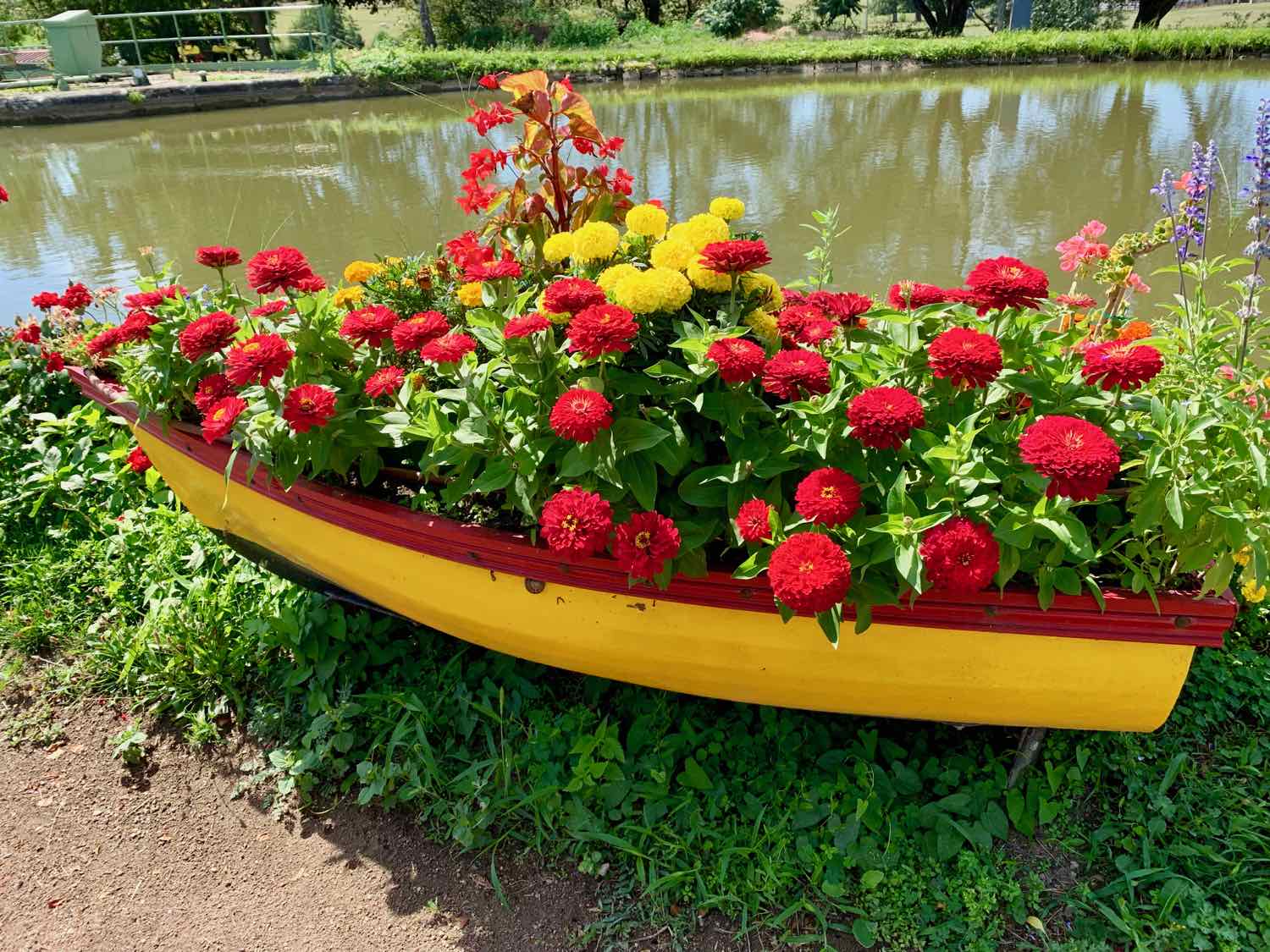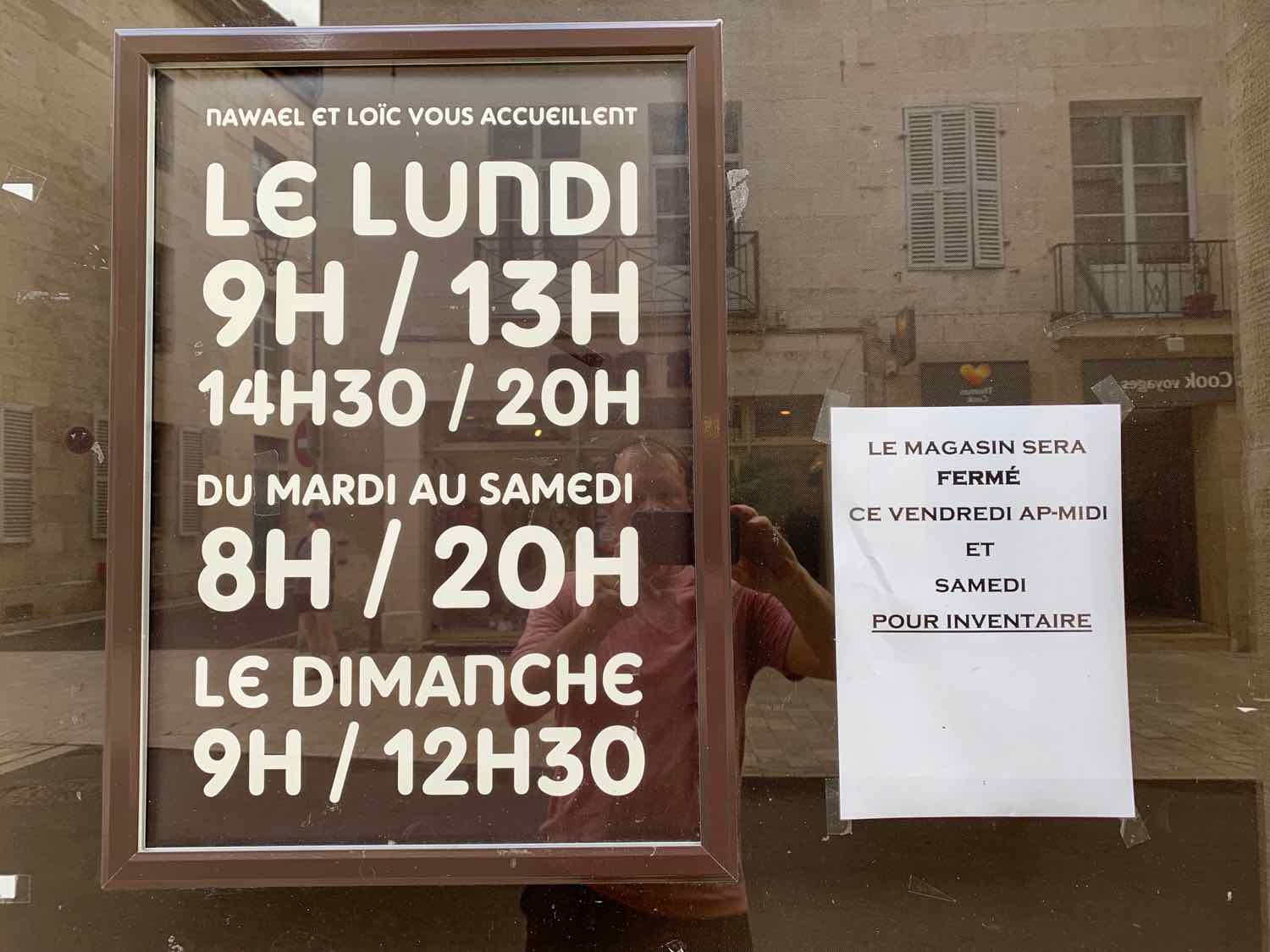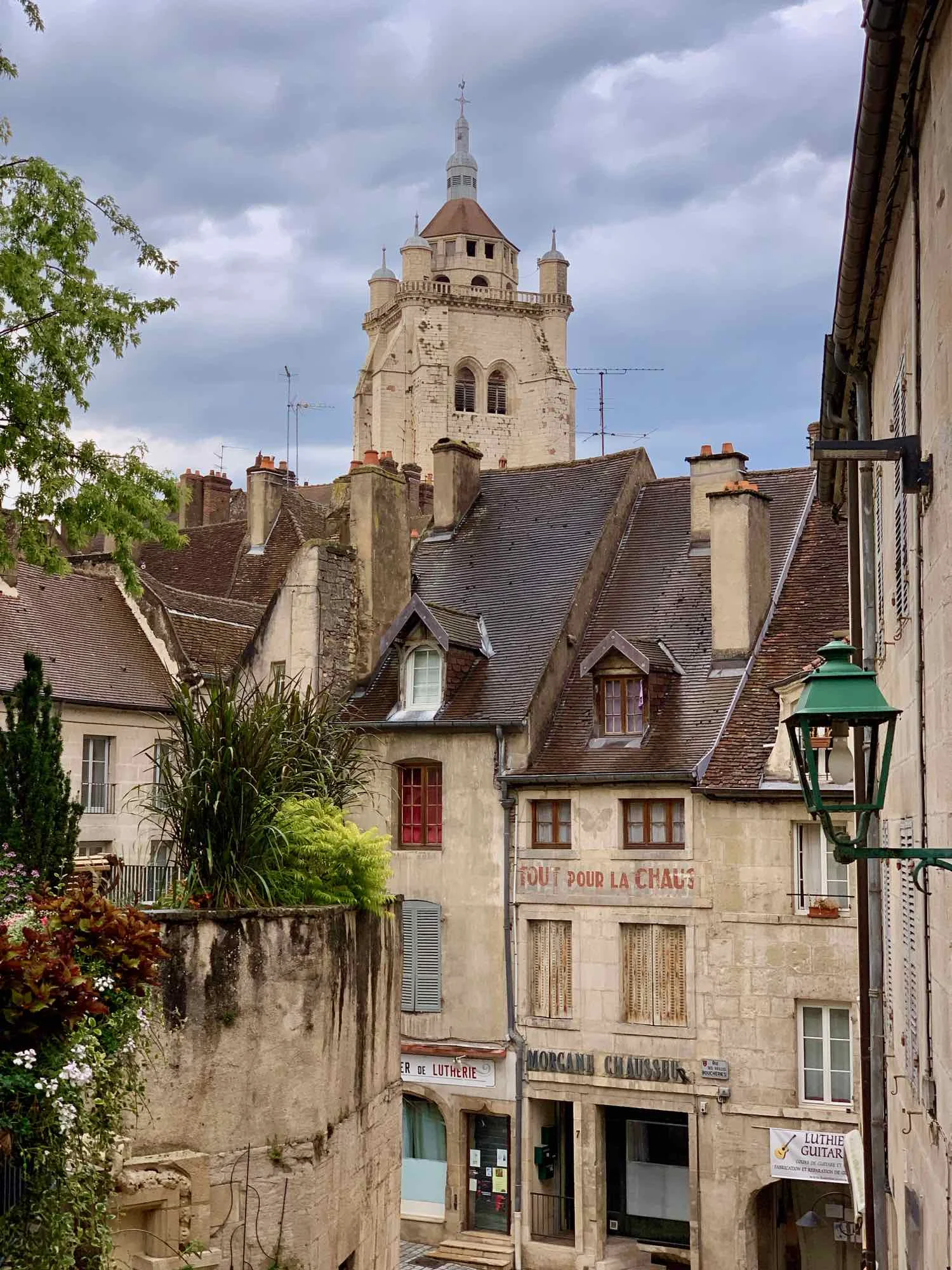Montceau-les-Mines to Dole, France: Cruising Along Canal Cycle Paths
8-9 August 2019
Montceau-les-Mines to Gergy (8 August 2019, 79.6 km, 49.5 mi)
It was a beautiful day for a ride. After two days filled with rain, the cold front has passed, and the sky is clear.
Out on the road, the biking went very fast. Today’s route was quite flat, mostly following the banks of the Canal du Centre across a broad plain covered with agricultural fields. Built in the late 1700s, this canal was the first to link southern and northern France. For more than 100 years, its major business was shipping coal from Montceau-les-Mines to other parts of the country. But the last of the mines closed in 2000, and now the canal handles mainly recreational boats.
We were amused to see these sunflowers popping up in a field of soybeans. Canal du Centre, France. Copyright © 2018-2019 Pedals and Puffins.
We’re definitely forming a pattern of planning shorter riding days, getting to our destination too early, and then biking further in the afternoon. The cycling here in France has been relatively easy, with lots of dedicated bike paths that are paved or that have hard-packed gravel surfaces. The terrain is often pretty gentle as well. Gone are the days of challenging terrain and bumpy trails from Spain and Portugal, and the steep hills in the English/Scottish moors. Lately we’ve been able to cover 70 km or more without much trouble. Today we had planned to go 50 km, but we arrived at the campsite at 11:30am. That’s way too early. Looking down the road, there was another campground in 34 km, so we kept going.
One particularly cheerful lock keeper’s house had a huge garden of flowers along the canal tow path. In addition to flowers planted in the ground, and in traditional flower beds, they also had flowers planted in a canoe, a wheel barrow, a wine press, old wooden barrels, and more. The flowers were growing thick, and looked like they received the best, loving care. It was all very festive and full of color.
This lock keeper’s garden provided a glorious splash of color along the Canal du Centre, Fontaines, France. Copyright © 2018-2019 Pedals and Puffins.
Of course, we were delighted to see a bicycle among the mix of objects being used in the lock keeper’s garden.
Flower garden at a lock along the Canal du Centre, Fontaines, France. Copyright © 2018-2019 Pedals and Puffins.
Taking a break from the afternoon sun. It’s wonderful when there are sections of the route that are fully shaded by the surrounding trees. Canal du Centre, France. Copyright © 2018-2019 Pedals and Puffins.
The kilometers continued to fly by. Around 70 km (43.5 mi) into the ride, we arrived at the banks of the Saône River (pronounced “son”). It’s a wonderfully scenic, tree-lined river in northwestern France that flows south into the Rhône River at Lyon. It was quickly apparent that the Saône is deeper and more suited to boat traffic than the Loire. We started seeing more recreational boats out on the river almost immediately.
We arrived at the second campground, located on the banks of the Saône River, shortly after 2:00pm. It’s a municipal campground, and as a result, it’s really low key. That’s fine by us.
The afternoon was really hot. So after setting up camp we headed into town looking for a way to cool down. At the local grocery store, we bought cold drinks and ice cream. There were only a couple of drinks in the store’s refrigerator, and we bought all they had. We took them to the town park, where we ate and sipped our drinks on a shaded park bench. It was relaxing and cooled us off nicely. Our entertainment was two local boys on bikes, who would race each other around the running track in the park, go tearing off in one direction or another, only to show up again in a few minutes. The park definitely seemed to be their home base.
We hung out in the park until 6pm, when the local kabob restaurant opened. It was the only restaurant in this very small town. As usual for kabob shops, the portions were enormous, and we were stuffed by the time we were done.
You’ll never go hungry at a kabob shop in Europe. They all serve huge portions. Gergy, France. Copyright © 2018-2019 Pedals and Puffins.
Later, back at the campground, we had a surprise visit from a fascinating type of bird. A large flock of European Bee-eaters flew over our campsite around 7:30 pm. Unfortunately, we couldn’t get our binoculars or camera out fast enough to get a good look at them. We heard them fly over, but only saw little specks of birds way up in the sky. This piqued our interest.
It turns out that the Saône River, along with the upper Loire and the Doubs River (which we will bike along soon), is prime bee-eater habitat. As their name implies, their favorite food is bees (along with hornets, wasps, crickets and other big bugs). They catch their meals on the wing like swallows do, often in big flocks like the one we saw. Another cool habit they have is that they nest in colonies, within burrows dug into sand banks along the river. And they’re beautiful, with a mix of deep rust and bright yellow on their backs and chin, overlaid on a turquoise/green belly and tail. We’d really like to get a better look at them before we leave France.
But tonight we had to settle for more down-to-earth entertainment - like the mobile trailer loaded up with a washer and dryer over in another campsite. We’ve never seen such a thing. It seems like a pretty big expense, to take your own washer and dryer with you when you camp. Until today, we didn’t even know it could be done.
A washer and dryer? Really? That seems like overkill for camping. Gergy, France. Copyright © 2018-2019 Pedals and Puffins.
We walked down to the river late in the evening. There were huge flocks of bee-eaters flying overhead, but they all were very high in the sky, and they didn’t show any signs of landing. Are they already migrating? We didn’t get any good looks at them tonight.
Along the way we saw another amusing warning sign. It let us know that cycling on the Blue Way (the local name for our route) is prohibited in case of a flood. Good to know. Graphic image of drowning cyclist included.
Bicycles do not make good boats in cases where the trail is flooded. Ok, got it. Gergy, France. Copyright © 2018-2019 Pedals and Puffins.
By 8:00pm the campground restaurant was buzzing with activity. A lot of folks dressed up for a night out were arriving by car. Based on what we observed, this restaurant is probably the nicest one in the area, and serves a lot more folks than just the campers. They had signs advertising upcoming events, like a swing dance evening. Luckily, there weren’t any special events the night we were there. The only noise came from some neighboring campers who went night fishing. But even they settled down eventually.
Gergy to Dole (9 August 2019, 77.9 km, 48.4 mi)
We were entertained this morning with the appearance of several huge slugs in the road. They’re really big and fat, so they’re pretty easy to spot. The first one we saw was about 12.5 cm (5 inches) long. They turned out to by Spanish Slugs. And although they may be native to western France (their native range is not certain), they apparently are highly invasive garden pests. It’s not too surprising. A slug that size would have quite an appetite.
Spanish slug crossing the road. Allerey-sur-Saône, France. Copyright © 2018-2019 Pedals and Puffins.
We stopped for breakfast in the lovely town of Verdun-sur-le-Doubs which, as it’s name implies, lies on the banks of the Doubs River.
Our splendid breakfast spot, overlooking the Doubs River. Verdun-sur-le-Doubs, France. Copyright © 2018-2019 Pedals and Puffins.
This morning we kind of over-did it. We had two quiches each, plus a pastry. PedalingGuy had flan and I had a cherry tart. They were absolutely fabulous. But we were both stuffed for most of the rest of the day.
We ate our breakfast overlooking the spot where the Petite Doubs flows into the Doubs River. At the bridge over the Petite Doubs, markers on a nearby building indicate the height of historic floods that tore through the city. The highest one was in 1910, which rose nearly 10 meters, and would have almost completely covered the bridge. But there have been other, more recent floods. And you can see the high water line on the building across the river. It’s quite sobering.
Bridge over the Petite Doubs River, Verdun-sur-le-Doubs, France. Markers on the building across the river show the levels reached by historical floods. Copyright © 2018-2019 Pedals and Puffins.
And… we finally got some great looks at the European Bee-eaters. Yay! Just like in the past, we heard them before we saw them. But this time, they weren’t flying way up in the stratosphere. A large group was catching bugs above an agricultural field. Much to our delight, some of them perched on a wire near the road. PedalingGuy whipped out his camera, and got some satisfying photos. It was still pretty early in the morning, and the light was at a tough angle. But you can clearly see the wonderful rust, yellow and turquoise colors of these charming birds.
Got him! Proof that we saw European Bee-eaters along EuroVelo 6. France. Copyright © 2018-2019 Pedals and Puffins.
It’s actually amazing how common the bee-eaters are along the Saône and Doubs Rivers. We heard them many times today. There are also many places in the banks of the river where you can see burrows in the sand that look like they might be used by bee-eaters. It’s pretty cool, like having a tropical species in Europe.
We stopped for a break under a tree at about 50 km. PedalingGuy decided it was time to once-and-for-all fix a squeak in his handlebar bag mount, that had been bothering him for several days. Unfortunately, when neither of us could recall exactly how the unexpectedly complex, Ortlieb mounting mechanism worked, he just started unscrewing bolts. Pretty soon the cables were drooping and we weren’t sure how to tighten them, since the bolts have to be tightened in a particular order. We’ve been told that getting the order wrong can ruin the mount, so we were a little concerned at this point.
Even though we have installed the mounts multiple times in the past, we had to resort to getting out the instruction manual, which we had brought with us as a pdf file. After struggling to figure out the directions again (they’re very hard-to-follow pictographs, with no words, for a complicated mount), we finally got things back on track. The right bolts were screwed in, in the correct order, and he was able to tighten the mount so it didn’t squeak anymore. Disaster averted. Whew.
After cycling 5 km further, we reached another milestone on our journey: the start of the Rhône-to-Rhine Canal. The canal links the North Sea to the Mediterranean, by connecting the Rhine River to the Rhône River. We’ll be following canal to the Rhine, where we’ll cross into Germany and Switzerland.
The western end of the Rhône-to-Rhine Canal. Saint-Symphorien-sur-Saône, France. Copyright © 2018-2019 Pedals and Puffins.
Not long after we started following the canal, we crossed paths with a large, Swiss-flagged, canal cargo ship, the WILLI. Right away we were impressed with the size of the boat - it was much wider and longer than the diminutive, recreational canal boats we’re used to seeing. It was moving pretty slowly, and we easily passed it. Little did we know that the WILLI would be with us for quite a while, as we both journeyed along the canal.
Our first sighting of the WILLI cargo ship on the Rhône-to-Rhine Canal. Saint-Symphorien-sur-Saône, France. Copyright © 2018-2019 Pedals and Puffins.
Rain was forecast for the afternoon, but we got to the campground in Dole with plenty of time to spare. We found a good, shady campsite, set up the tent, got all our stuff packed away, and even showered before any rain started. Just as we were setting up our picnic table for dinner, it started to drizzle. We dashed back to the tent with our food, and thought about what to do. Luckily, it was just a passing shower. So we walked over to the main snack bar, where they had some covered picnic tables, and ate our dinner there. A few more showers passed while we were eating, so we were glad to have the cover.
After dinner, we walked into the town of Dole. It has an atmospheric, old, historic center dominated by a huge church (as big as a cathedral) on top of a hill (of course).
The afternoon was very hot (in the 90s) and so far the rain had not done much to cool things down. So, our first priority was finding cold drinks. We headed straight for the nearby mini-supermarket, that was supposed to be open until 8pm. But, nooooo! They were closed. Seriously. They were fermé (closed) all day today to do inventory. We have no experience in the States where a supermarket will close its doors during regular, daytime, business hours to take inventory. It’s unheard-of. We were totally not expecting that.
We went across the street and bought two, cold, drinks to-go at a restaurant. Then, we walked over to a nearby bench to drink. That’s when we saw the tourist office. We went over and asked the guy at the desk where the next, nearest supermarket would be. He pointed us towards one up the road, about 0.3 km away. Off we went.
This store didn’t have any refrigerated drinks but it was wonderfully cool in the supermarket, and just being inside the air conditioning was very pleasant. Although the bottled drinks were not refrigerated, they were significantly cooler than the water in our water bottles that had been in the sun all day. Not so bad, I guess.
While we were in the supermarket getting ready to check out, the sky opened up and rain started pouring down. It was a real soaker, so we decided to wait. Ten minutes later, it had totally stopped raining. Nice.
Then we walked around town. We saw the huge Church of Notre Dame up close, plus some other sights in the old part of town.
Wandering the streets of the old city. Dole, France. Copyright © 2018-2019 Pedals and Puffins.
Mural depicting famous people in the history of the city. Dole, France. Copyright © 2018-2019 Pedals and Puffins.
Back at the campground, we thought we might sit out in our camp chairs for a while. But it was still raining off-and-on, so we retreated into the tent. There’s a nice breeze starting to cool things down. It should be a comfortable night.








